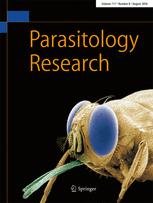Ver ítem
- xmlui.general.dspace_homeCentros Regionales y EEAsCentro Regional Santa FeEEA RafaelaArtículos científicosxmlui.ArtifactBrowser.ItemViewer.trail
- Inicio
- Centros Regionales y EEAs
- Centro Regional Santa Fe
- EEA Rafaela
- Artículos científicos
- Ver ítem
New records and host associations of the tick Ixodes apronophorus and the first detection of Ehrlichia sp. HF in Romania
Resumen
Ixodes (Ixodes) apronophorus is a neglected tick species and its geographical distribution, host associations, and role as a disease vector are not well known. We collected I. apronophorus from several locations in Romania. Morphological identification of ticks was confirmed by analysis of 16S rDNA and 12S rDNA gene sequences. We report new host associations of I. apronophorus, which was collected from dogs, foxes, and a hare—all new hosts for this tick
[ver mas...]
Ixodes (Ixodes) apronophorus is a neglected tick species and its geographical distribution, host associations, and role as a disease vector are not well known. We collected I. apronophorus from several locations in Romania. Morphological identification of ticks was confirmed by analysis of 16S rDNA and 12S rDNA gene sequences. We report new host associations of I. apronophorus, which was collected from dogs, foxes, and a hare—all new hosts for this tick species in Romania. Furthermore, we report for the first time occurrence of Ehrlichia sp. HF in I. apronophorus. Ehrlichia sp. HF was identified by sequencing a part of the 16S rDNA gene and was found in 16% (3/19) of the tested ticks. Ehrlichia sp. HF has not been previously reported in Eastern Europe and seems to have a much larger geographic distribution than previously known. Currently, it is unknown whether I. apronophorus is a competent vector for Ehrlichia sp. HF, or if the findings in this study represent infection in the hosts, namely dogs and fox.
[Cerrar]

Autor
Andersson, Martin O.;
Radbea, Gabriel;
Frangoulidis, Dimitrios;
Tomaso, Herbert;
Rubel, Franz;
Nava, Santiago;
Chitimia-Dobler, Lidia;
Fuente
Parasitology Research 117 (4) : 1285–1289 (April 2018)
Fecha
2018-04
ISSN
0932-0113
1432-1955
1432-1955
Formato
pdf
Tipo de documento
artículo
Palabras Claves
Derechos de acceso
Restringido
 Excepto donde se diga explicitamente, este item se publica bajo la siguiente descripción: Creative Commons Attribution-NonCommercial-ShareAlike 2.5 Unported (CC BY-NC-SA 2.5)
Excepto donde se diga explicitamente, este item se publica bajo la siguiente descripción: Creative Commons Attribution-NonCommercial-ShareAlike 2.5 Unported (CC BY-NC-SA 2.5)

